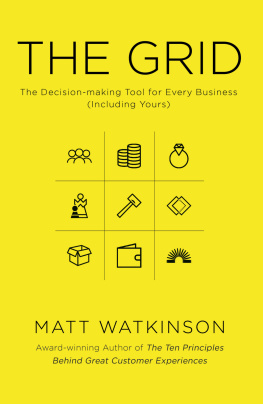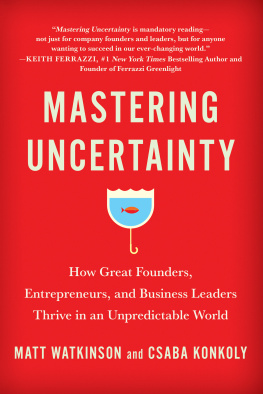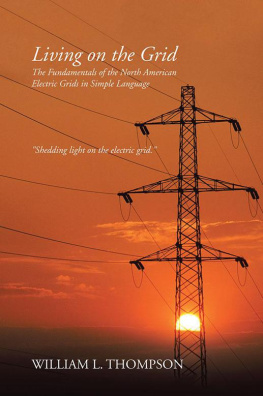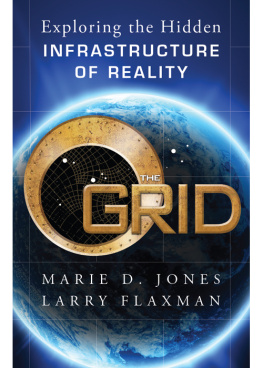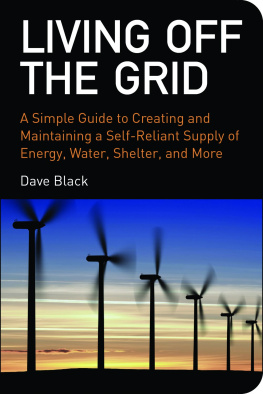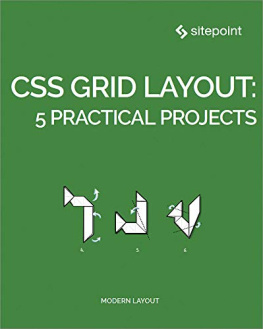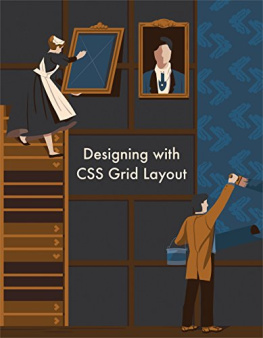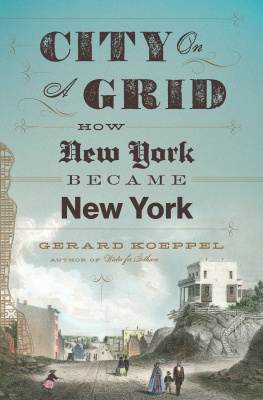The Grid
The Decision-Making
Tool for Every Business
(Including Yours)
Matt Watkinson
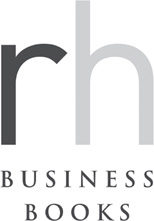
This ebook is copyright material and must not be copied, reproduced, transferred, distributed, leased, licensed or publicly performed or used in any way except as specifically permitted in writing by the publishers, as allowed under the terms and conditions under which it was purchased or as strictly permitted by applicable copyright law. Any unauthorized distribution or use of this text may be a direct infringement of the authors and publishers rights and those responsible may be liable in law accordingly.
Epub ISBN: 9781473537859
Version 1.0
Published by Random House Business Books 2017
1 3 5 7 9 10 8 6 4 2
Copyright Matt Watkinson 2017
Matt Watkinson has asserted his right to be identified as the author of this Work in accordance with the Copyright, Designs and Patents Act 1988
First published by Random House Business Books in 2017
Random House Business Books
20 Vauxhall Bridge Road,
London, SW1V 2SA
www.penguin.co.uk
Random House Business Books is part of the Penguin Random House group of companies whose addresses can be found at global.penguinrandomhouse.com
A CIP catalogue record for this book is available from the British Library
ISBN 9781847947949 (hardback)
ISBN 9781847941879 (trade paperback)
For my dad, who taught me how to learn.
Authors Note
On one level, this is a straightforward business book. The grid is a tool to help you make better decisions. It provides a structure for identifying both issues and opportunities within existing businesses, and for putting new business ideas to the test all with no prior experience necessary. But its underlying motive is deeper than that.
Most of us have a professional ambition of one kind or another. Some dream of working for themselves, others to rise within the ranks of their employer. Many love their job just as it is, but want to broaden their knowledge. Pursuing and achieving these goals can be immensely rewarding and fulfilling.
This book aims to help you towards those goals whatever they might be by improving the decisions youll make along the way. In doing so, its true aim is to contribute to your success and well-being as an individual, and those of society as a whole.
The mathematician George E. P. Box once remarked, Essentially, all models are wrong, but some are useful. He rightly believed that models can never represent the complexity of the real world, but that they are valuable anyway. They bring structure to our thinking, and help us tame that complexity. They illuminate the problems we seek to solve.
In the grid, I hope you will find a model thats a little less wrong, and a little more useful than the alternatives.
Matt Watkinson
26 December 2016
Acknowledgements
Id like to take this opportunity to thank the following: my wife Louise for her tireless support, encouragement and understanding. Patrick Walsh and Carrie Plitt, whose input on the early ideas was invaluable. Nigel Wilcockson at Random House for commissioning and editing the book.
My dear friend, confidant and minister for brevity, Ben Smith. Whatever I have done, he has always found a way to make it better. Natalie Malevsky, who has been part of this journey from the start and has never lost enthusiasm for the project. My family John Watkinson and Howard Watkinson. Arthur Nurse, who created the beautiful icons, Peter Kremmer and the team at Dekoratio for graphic design work, and Panos Damaskinidis.
My thanks to the following for their feedback and insight: Csaba Konkoly, Walter Kiechel, Alex Bromage, Ian Storrar, Diana McKenzie, Shelley Stanford, John Maddigan, Mikael Reichel, John Syfret, Cat Funk, David Pinder, Sionade Robinson, Marco Seiler, Rory Sutherland, Andy Puddicombe, Anna Berger, Janina Rustige, Philip Rowley, Emma Honeybone, Edd Read, Tim Leake, Scott Redick, Bruce Lampcov, Thomas Eriksen, Anne Heinung, Nick Livesey, Clive Stevenson, John Sills, Adam Bice, Mark Simpson, Marc Provissiero, Lorna Morris, Roland Geeraedts, Nigel Pepper, Bernard Grenville-Jones, Bonnie Austin, Sam Aborne, Kristin Peck, Don Spetner, Per Sjfors, Mica Vaipan, Matthias Bader, Arif Haq and Will Sansom at Contagious, Kal Patel, Deborah Dolce, Tamar Cohen, Tim and Anthony Pask, and Rob Isaacs.
To Nicole Parsons for the inspiration.
To the members of my Buddhist community, whose guidance and encouragement were invaluable: Kim Upton, Sean and Liz Ruiz and all of the Lotus Lions District in Beverly Hills.
To friends who supported and distracted in equal measure: Hans Mills, James Cooper, Adam Davis, Will Skjtt, Megan Butler, Ben Wall, Draa Jansky, Raph Colson, Brooke Wescott, Jono OConnor and countless others.
Finally, to the hundreds of authors from whose work I learned so much.
Introduction
As you can see, Mr Watkinson, we really have no choice but to operate, the doctor said, pointing to a fuzzy-looking scan on the screen.
On which one? I asked.
Both.
Id been training hard for a few months lifting weights, cycling and running when my knees had started to hurt. Eventually the pain was bad enough that Id had to stop exercising altogether and had ended up at the surgeons office. He booked me in for an arthroscopic procedure the following week, on both knees.
Six months later it was clear the surgery hadnt fixed the problem. I was still in pain and couldnt exercise. I saw physiotherapists and osteopaths, I squashed my lower half with a foam roller. Nothing made any difference. In a final attempt to get help I called Nicole Parsons, a local sports rehabilitation expert.
She listened patiently to my woes, then unpacked some high-tech equipment from her bag: a ruler, a camera and a clipboard with some blank stick figures on it. After taking photos and making some measurements, she sketched over the top of the stick figures and presented her diagnosis.
The problem, she explained, had nothing to do with my knees: my muscle groups were imbalanced, from my shoulders down to my feet. This meant my hips were out of alignment with my knees, so when I moved my legs, the bones and joints were pulled all over the place, hence the pain. Using an approach called the Egoscue Method, she prescribed exercises to rebalance my muscles and resolve my postural issues. Her approach worked. With regular sessions and sticking to the programme, I was soon up and running again.
As I lay sprawled on her mat, it struck me that this situation was similar to what I experienced at work. People would make a decision in one part of a business, without realising how it might impact another; wed identify a problem and try to fix it without identifying the root cause, often making matters worse. Everyone jumped straight to specialist surgery nobody looked at the whole as Nicole had done. I wondered whether learning more about her approach might help my work and asked her for some book recommendations.
Surprised at my interest, she recommended a book called Anatomy Trains, which explains how the bodys muscles are connected into one system. I ordered the book that evening, oblivious to how my knee surgery and that conversation with Nicole would lead to the book youre now reading.
These events coincided with an exciting time in my professional life. About two years earlier, working as an independent designer, Id arrived at the conclusion that the way we approached making products, services and customer experiences better could be dramatically improved.

